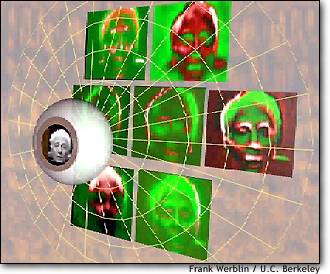| Scientists uncover secrets of
sight | |
| Brain does most
of
the work,
using sketchy
data from eyes,
researchers
say | |

| A computer simulation, created by David
Balya from research information, shows seven of the dozen separate "movies" that
the eye extracts from a scene and sends to the brain.
|
| | |
 |
| | | LONDON, March 28 - Scientists may have
come a step closer to the creation of a bionic eye, thanks to new research
showing how the eye provides sketchy images that the brain interprets to create
what we see. |
|
A BIONIC EYE using a computer microchip to restore
sight is still a very long way off, but researchers at the University of
California Berkeley have uncovered new secrets about how we see.
"Even though we think we see the world so
fully, what we are receiving is really just hints, edges in space and
time," said Frank Werblin, a professor of molecular and cell biology.
Werblin and his colleague Botond Roska discovered
that the eye has about 10 to 12 output channels each carrying information to the
brain which then constructs images.
Writing in Thursday's issue of the journal Nature,
they showed that the retina of the eye creates a stack of image representations
that arise as the result of communication between layers of cells in the
retina.
Roska's father, Tamas Roska, and Leon Chua
- who also work at the university - invented a computer microchip
called the Cellular Neural Network that they say can be programmed to do visual
processing just like the retina. They contend that the new chip could form the
basis of a bionic eye.
"The biology we are learning is going into
improving the chip, which is getting more and more similar to the mammalian
retina," Botond Roska said in a statement.
But before a bionic eye can become a reality,
scientists must discover how to connect the chip to the complicated circuitry in
the brain.
The researchers discovered the output channels by
meticulously measuring signals from ganglion cells, the eye's output cells
to the brain, in rabbits while flashing images of squares or circles in front of
the animals.
They found that groups of ganglion cells represented
different visual features and sent the information to different paths in the
brain.
Hungarian software designer David Balya then used
their findings on a computer model that mimics the ganglion cells in the
retina.
"We are now looking at the predictions the
model makes when viewing natural scenes...and comparing them with what we
measure in actual retinal cells, to learn how good the predictions are,"
said Roska.
Published version on MSNBC
The longer press release from Berkeley

